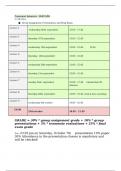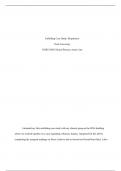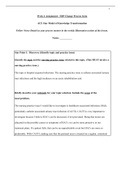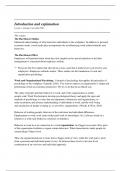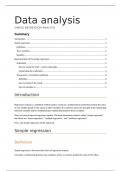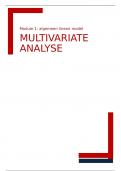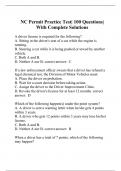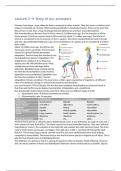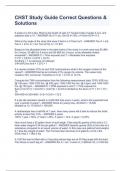Consumer behavior - BM01MM
dr. DR Schley
● Group Assignment, Presentation, and Final Exam
Lecture 1
wednesday 06th september 15:00 - 17:45
Lecture 2
thursday 07th september 13:00 - 15:45
Lecture 3
wednesday 13th september 13:00 - 15:45 13:45
Lecture 4
thursday 14th september 13:00 - 15:45
Lecture 5
wednesday 20th september 13:00 - 15:45
Lecture 6
thursday 21st september 13:00 - 15:45
Lecture 7
tuesday 26th september 15:00 - 17:45 ! missed last 30
minutes
Lecture 8
thursday 28th september 13:00 - 15:45. (look at teres recording)
Lecture 9
wednesday 4th october 14:00 - 16:45
EXAM
25th october 18:30 - 21:30
GRADE = 30% * group assignment grade + 10% * group
presentations + 5% * teammate evaluations + 55% * final
exam grade
Due: 23:59 pm on Saturday, October 7th presentation 10% paper
30% Attendance in the presentation classes is mandatory and
will be checked!
,survey by 23:59 pm on Friday, October 13th.
LECTURE 1 - Wednesday 6th September
o General Theoretical Framework. (e.g. Associative Network)
o Specific Theoretical Framework. (e.g. Branding Theories)
o Effects. (e.g. Mere exposure effect)
Mere-Exposure Effect:
The idea that you have more positive attitudes towards things you are familiar with.
If you see someone around often you like them more than someone you’ve never
seen before
We would rather buy familiar brand products than unknown alternatives at the
store. This is also the reason why entering a new market is so hard – consumer are
‘loyal’ to priducts they know (we hardly Δ)
Case Study: Zajonc (1968) presented participants with fake Chinese symbols = participants
felt more positively (i.e., they liked) the symbols that were presented more frequently.
Consumer behavior (def) :
Avery et al.: Set of mental and physical activities undertaken
by consumers to acquire and consume products as to fulfill
their needs and wants.
Peter & Olson: Dynamic interactions of affect, cognition, and
behavior, with events in the environment, that are associated
with the “exchange aspects” of human life.
Cognition refers to our thoughts about and interpretations
Affect refers to the feelings that we experience; it includes both
moods and emotions.
Hence: our feelings and perceptions influence our behavior
Consumer Puzzles:
People don’t behave like we would expect them to according to economic models /
theories (rational choice theory)
Often times people (consumers) may engage in behavior that is not really rational. Meaning
behavior that could ultimately not be in-line with what they are trying to achieve.
e.g. Escalators to the gym. This impedes the goal of moving / being physically fit
, another example of a consumer puzzle.
Usually, according to economic theory, the price drops if
more quantities are sold… however, as we know this is not
the case with Apple.
Who studies consumer behaviour:
1. Marketers
2. Social Organizations
3. Public Policy Makers
Consumer Decision Process Model (7steps)
1. Need Recognition
Need → Discrepancy between actual and desired state
A Δ in desired state (out of the indifference zone) will
cause us to act on it (act out)
Increase in desired state or decrease in actual state
What causes shifts / changes in desired state?
Life stage changes
New tastes
New technologies
What causes shifts / changes in actual state?
Stock depletion (always have frozen food in freezer in case)
Problem removal (have cleaning supplies on hand)
Problem Avoidance (insurance)
2. Search for Information
2 forms of information search → Internal or External information search
External Information Search:
Marketer Sources: From company → Advertising, company websites, stores, brochures
Non-Marketer Sources: Outside the company → Other consumers (Family & friends),
consumer organizations, government, media
, INFORMATION PROCESSING
Heuristic Search (low effort)
Systematic Search (high effort)
Ad-hoc Organized
Convenience based Comprehensive
Relies on rules of thumb effortful
Less risk More Risk
Low level of involvement High level of involvement
More knowledge on topic b4hand Less knowledge on topic b4hand
Takes less time / when we have less time Takes more time / when we have more time
e.g. toothpaste e.g. buying house
Consideration Set
The “consideration set” is the set of brands actively
considered at the time of choice.
In order for a customer to choose action A (e.g.,
brand A), Brand A must be considered
In order for a customer to choose action A (e.g.,
brand A), the customer must fail to consider a
brand he/she likes better than brand A
3. Pre-purchase evaluation of alternatives
Slide47
4. Purchase
5. Consumption
Timing, frequency, volume of use
Important for packaging (storage)
Affects satisfaction
Mode of use:
Proper use (follow instructions)
Alternate uses (e.g. The pool noodle)
dr. DR Schley
● Group Assignment, Presentation, and Final Exam
Lecture 1
wednesday 06th september 15:00 - 17:45
Lecture 2
thursday 07th september 13:00 - 15:45
Lecture 3
wednesday 13th september 13:00 - 15:45 13:45
Lecture 4
thursday 14th september 13:00 - 15:45
Lecture 5
wednesday 20th september 13:00 - 15:45
Lecture 6
thursday 21st september 13:00 - 15:45
Lecture 7
tuesday 26th september 15:00 - 17:45 ! missed last 30
minutes
Lecture 8
thursday 28th september 13:00 - 15:45. (look at teres recording)
Lecture 9
wednesday 4th october 14:00 - 16:45
EXAM
25th october 18:30 - 21:30
GRADE = 30% * group assignment grade + 10% * group
presentations + 5% * teammate evaluations + 55% * final
exam grade
Due: 23:59 pm on Saturday, October 7th presentation 10% paper
30% Attendance in the presentation classes is mandatory and
will be checked!
,survey by 23:59 pm on Friday, October 13th.
LECTURE 1 - Wednesday 6th September
o General Theoretical Framework. (e.g. Associative Network)
o Specific Theoretical Framework. (e.g. Branding Theories)
o Effects. (e.g. Mere exposure effect)
Mere-Exposure Effect:
The idea that you have more positive attitudes towards things you are familiar with.
If you see someone around often you like them more than someone you’ve never
seen before
We would rather buy familiar brand products than unknown alternatives at the
store. This is also the reason why entering a new market is so hard – consumer are
‘loyal’ to priducts they know (we hardly Δ)
Case Study: Zajonc (1968) presented participants with fake Chinese symbols = participants
felt more positively (i.e., they liked) the symbols that were presented more frequently.
Consumer behavior (def) :
Avery et al.: Set of mental and physical activities undertaken
by consumers to acquire and consume products as to fulfill
their needs and wants.
Peter & Olson: Dynamic interactions of affect, cognition, and
behavior, with events in the environment, that are associated
with the “exchange aspects” of human life.
Cognition refers to our thoughts about and interpretations
Affect refers to the feelings that we experience; it includes both
moods and emotions.
Hence: our feelings and perceptions influence our behavior
Consumer Puzzles:
People don’t behave like we would expect them to according to economic models /
theories (rational choice theory)
Often times people (consumers) may engage in behavior that is not really rational. Meaning
behavior that could ultimately not be in-line with what they are trying to achieve.
e.g. Escalators to the gym. This impedes the goal of moving / being physically fit
, another example of a consumer puzzle.
Usually, according to economic theory, the price drops if
more quantities are sold… however, as we know this is not
the case with Apple.
Who studies consumer behaviour:
1. Marketers
2. Social Organizations
3. Public Policy Makers
Consumer Decision Process Model (7steps)
1. Need Recognition
Need → Discrepancy between actual and desired state
A Δ in desired state (out of the indifference zone) will
cause us to act on it (act out)
Increase in desired state or decrease in actual state
What causes shifts / changes in desired state?
Life stage changes
New tastes
New technologies
What causes shifts / changes in actual state?
Stock depletion (always have frozen food in freezer in case)
Problem removal (have cleaning supplies on hand)
Problem Avoidance (insurance)
2. Search for Information
2 forms of information search → Internal or External information search
External Information Search:
Marketer Sources: From company → Advertising, company websites, stores, brochures
Non-Marketer Sources: Outside the company → Other consumers (Family & friends),
consumer organizations, government, media
, INFORMATION PROCESSING
Heuristic Search (low effort)
Systematic Search (high effort)
Ad-hoc Organized
Convenience based Comprehensive
Relies on rules of thumb effortful
Less risk More Risk
Low level of involvement High level of involvement
More knowledge on topic b4hand Less knowledge on topic b4hand
Takes less time / when we have less time Takes more time / when we have more time
e.g. toothpaste e.g. buying house
Consideration Set
The “consideration set” is the set of brands actively
considered at the time of choice.
In order for a customer to choose action A (e.g.,
brand A), Brand A must be considered
In order for a customer to choose action A (e.g.,
brand A), the customer must fail to consider a
brand he/she likes better than brand A
3. Pre-purchase evaluation of alternatives
Slide47
4. Purchase
5. Consumption
Timing, frequency, volume of use
Important for packaging (storage)
Affects satisfaction
Mode of use:
Proper use (follow instructions)
Alternate uses (e.g. The pool noodle)

